Your cart is currently empty!
The Role of Content Pillars, Content Ideas, and Content Goals in Your Overall Content Strategy
•
This page may contain affiliate links. If you follow a link to sign up or make a purchase, I’ll earn a small commission at no cost to you.

If you’re reading this, I’m willing to guess you struggle with content marketing— more specifically, you struggle with content consistency and effectiveness.
You don’t know how to create an effective content strategy or how to use your plan to create valuable content for your audience.
What if I told you a content strategy doesn’t have to be complicated? That it can be broken down into three parts and once you understand these three parts, everything else becomes clearer.
In this blog post, you’ll learn about the role content pillars, content ideas, and content goals play in your overall content strategy.
P.s. I’m not saying these three things are all there is to a content strategy; I’m saying they play very important parts.
Once you understand these three parts, the content creation process becomes simpler, and you’ll know the type of content your audience loves.
So let’s get into it.
What Are Content Pillars?
Before you read further, you should know I wrote a more comprehensive post on content pillars and how to create them for your business.
You should read it if you want a deeper understanding of content pillars.
Content pillars are the broad themes or core topics that define what your business stands for and the type of content you consistently produce.
They serve as the structural framework that holds up all your content and ensures your messaging remains cohesive, strategic, and aligned with your business’s goals.
The Role Content Pillars play in your content strategy
They Provide Clarity & Direction
Without defined content pillars, your content can feel scattered and inconsistent. You have nothing to guide you, so you just post anything you think is related to your business.
When you have core themes for which you want your business to be known, it ensures that every piece of content you create supports your brand identity and business goals.
They Boost SEO & Search Rankings
Search engines love authority. It’s why the acronym E-E-A-T exists. It stands for Experience, Expertise, Authoritativeness, and Trustworthiness.
Using content pillars to structure your content around specific topics makes you stand out as an expert with authority in your niche. This flags your business as high quality and contributes to how search engines push out your content.
They Streamline Content Creation
Instead of scrambling for content ideas every week, you have a content framework that guides your brainstorming process, making content planning much more efficient.
How to Define Your Content Pillars
Let’s go through how you can create content pillars for your business.
Step 1- Identify Your Business Niche & Goals – What do you want your business to be known for? What are your goals, your mission, and your vision? Make sure you have a clear understanding of this.
Step 2- Understand Your Audience’s Pain Points – who is your target audience? What do they need? What topics matter most to them? What are their problems and challenges?
Step 3- Analyze Competitor Content – What are your competitors talking about? What does their content look like? Are there any gaps or topics they aren’t covering?
Step 4- Create your pillars – Take all the information from steps 1-3. What are the common patterns? Write them down, and aim to have 3-5 broad and defined content pillars. Make sure your pillars reflect your business goals and values.
Step 5- Test & Refine – Monitor how the pillars perform with your audience. Some might do well, and others might not. Take note of audience engagement and adjust your pillars based on performance.
If you want a more comprehensive step-by-step process to defining your content pillars, you should get this free content pillar workbook template.
Examples of Content Pillars for Different Businesses
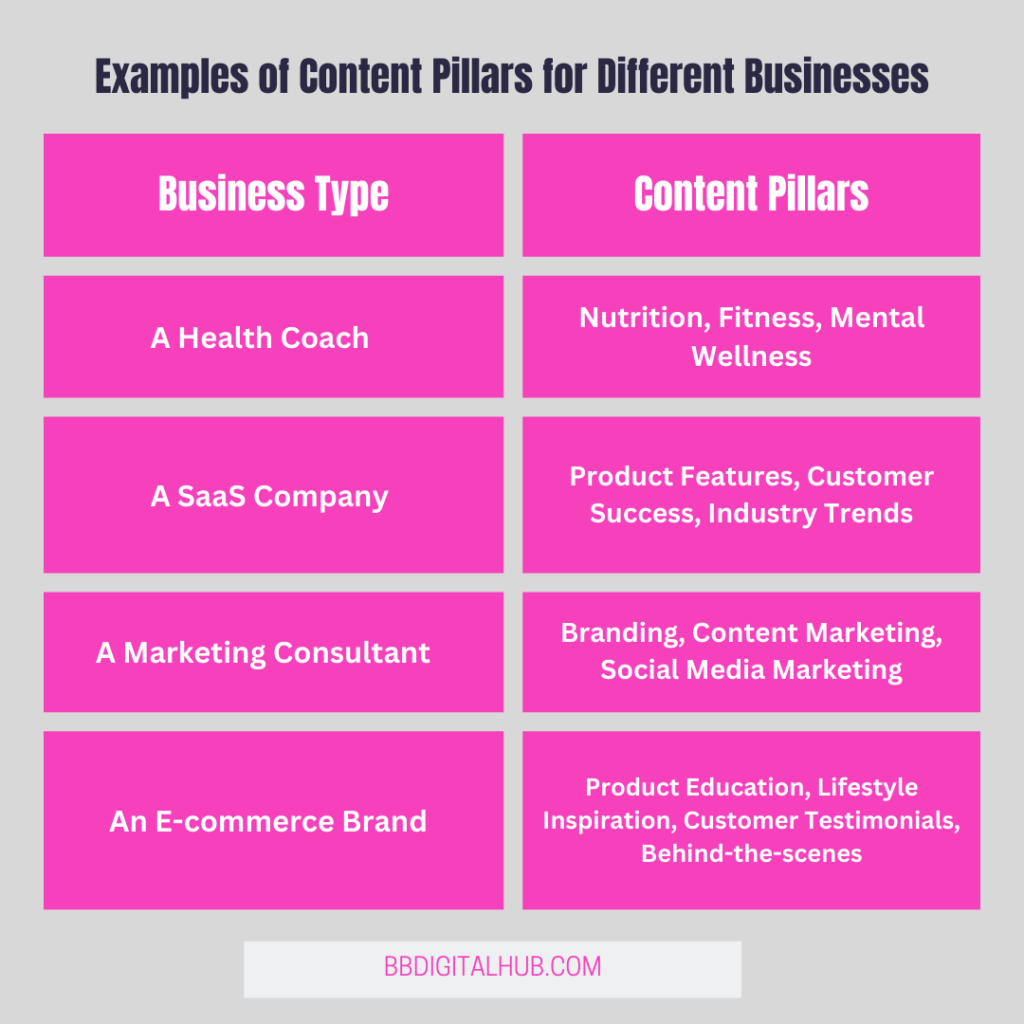
Content pillars serve as a strong foundation for your overall content strategy; they guide your content creation and ensure that every piece of content you create aligns with your business’s goals and mission.
What Are Content Ideas?
Once your content pillars are in place, the next step is to brainstorm your content ideas.
Your content ideas are the specific topics or pieces of content that fall under each broad theme or pillar. They represent the daily, weekly, or monthly content you create, whether it’s a blog post, video, infographic, email, or social media post.
This is what your audience gets to see.
Think of your content pillars as the big buckets; inside each big bucket, you have many content ideas.
Why Content Ideas Matter for your overall strategy
They Keep Your Content Fresh & Engaging
A strong list of content ideas ensures you never run out of things to post, keeping your audience engaged over time.
Manageable Creation Process
With a bank of ideas, content creation becomes a streamlined and easier task.
They Support SEO & Keyword Optimization
Like content pillars, creating content ideas around relevant search queries helps your business rank higher on Google, driving organic traffic to your website.
They Help Diversify Your Content Formats
Content ideas can be repurposed into multiple formats—blogs, videos, podcasts, social media posts, etc.—helping you reach a wider audience.
They Align Your Messaging with Business Goals
When planned strategically, your content ideas guide your audience toward the next step you want them to take, whether that’s signing up for a newsletter, making a purchase, or engaging with your brand.
How to come up with Content Ideas
- Use Keyword Research Tools – Google Trends, SEMrush, AnswerThePublic.
- Repurpose High-Performing Content – Turn an old blog post into a YouTube video, infographic, or social media post.
- Ask Your Audience –no one knows what they want from you better than your audience, so ask them. Use polls, read comments, ask them for reviews, or analyze FAQs.
- Monitor Industry Trends – Stay updated with new developments in your niche.
If you want more ideas on how to come up with content ideas your audience loves check out this post.
Examples of Content Ideas Under a Content Pillar
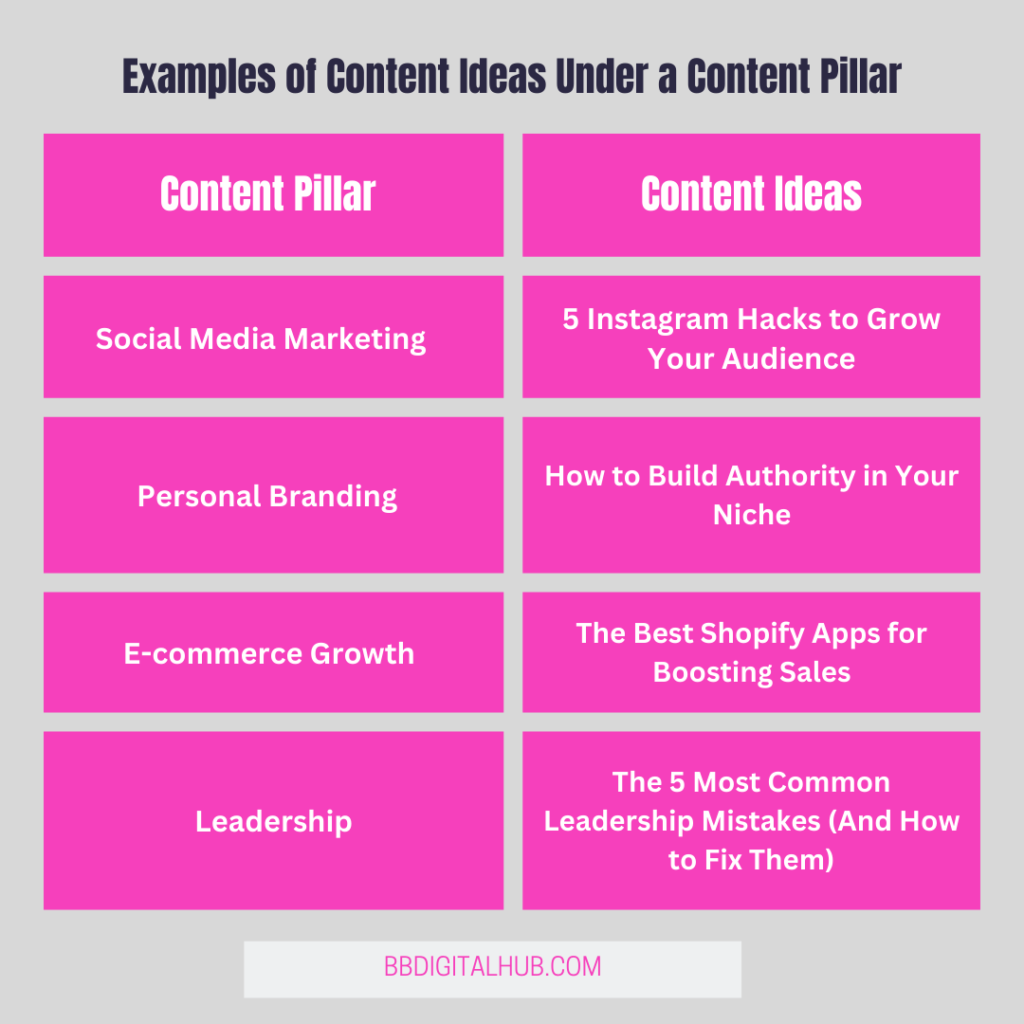
By generating creative and relevant content ideas, you ensure that every piece of content supports your pillars and keeps your audience engaged and informed.
What Are Content Goals?
While content pillars set the foundation and content ideas build on it, your content goals provide the direction and measure the impact of your efforts.
They define the purpose and intended outcome of your content.
You’re not just creating content for no reason. Every piece of content you create should serve a specific goal, whether that’s to educate your audience, have them know more about your business, generate leads, or convert sales.
Why Content Goals Matter to your overall strategy
They Ensure Every Piece of Content Has a Purpose
Without content goals, you’re just creating for the sake of creating—wasting your time and resources.
They Help You Measure Success
Setting goals allows you to track content performance and refine your strategy based on data. The only way to know what’s working is to measure and monitor.
They Align Content with Business Growth
Whether your goal is brand awareness, lead generation, or conversions, content goals ensure your content contributes to your business’s bottom line.
Guiding Distribution
Knowing your content goals helps you select the right content formats and distribution channels.
Types of Content Goals and Their Formats:
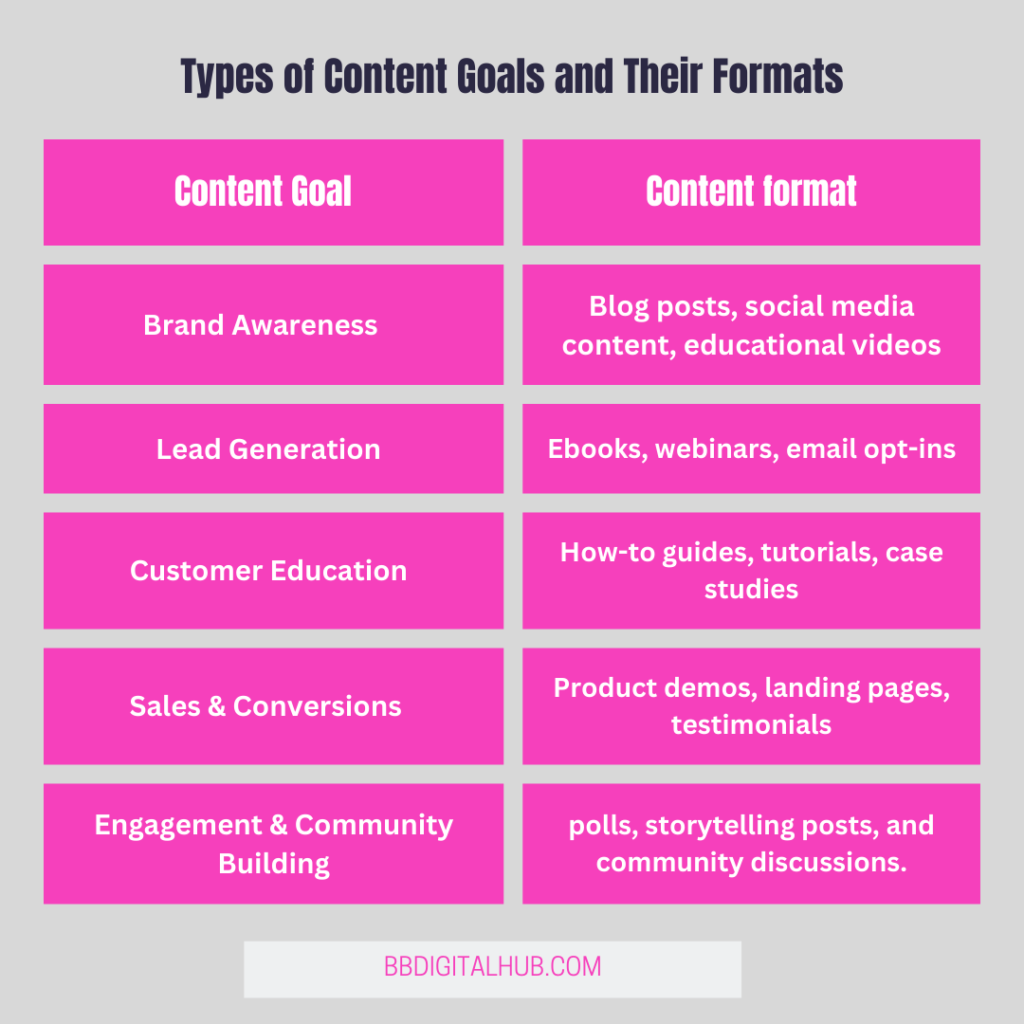
With well-defined content goals, you can measure success accurately and adjust your strategy to continuously improve your results.
How Content Pillars, Content Ideas, and Content Goals Work Together for Your Strategy
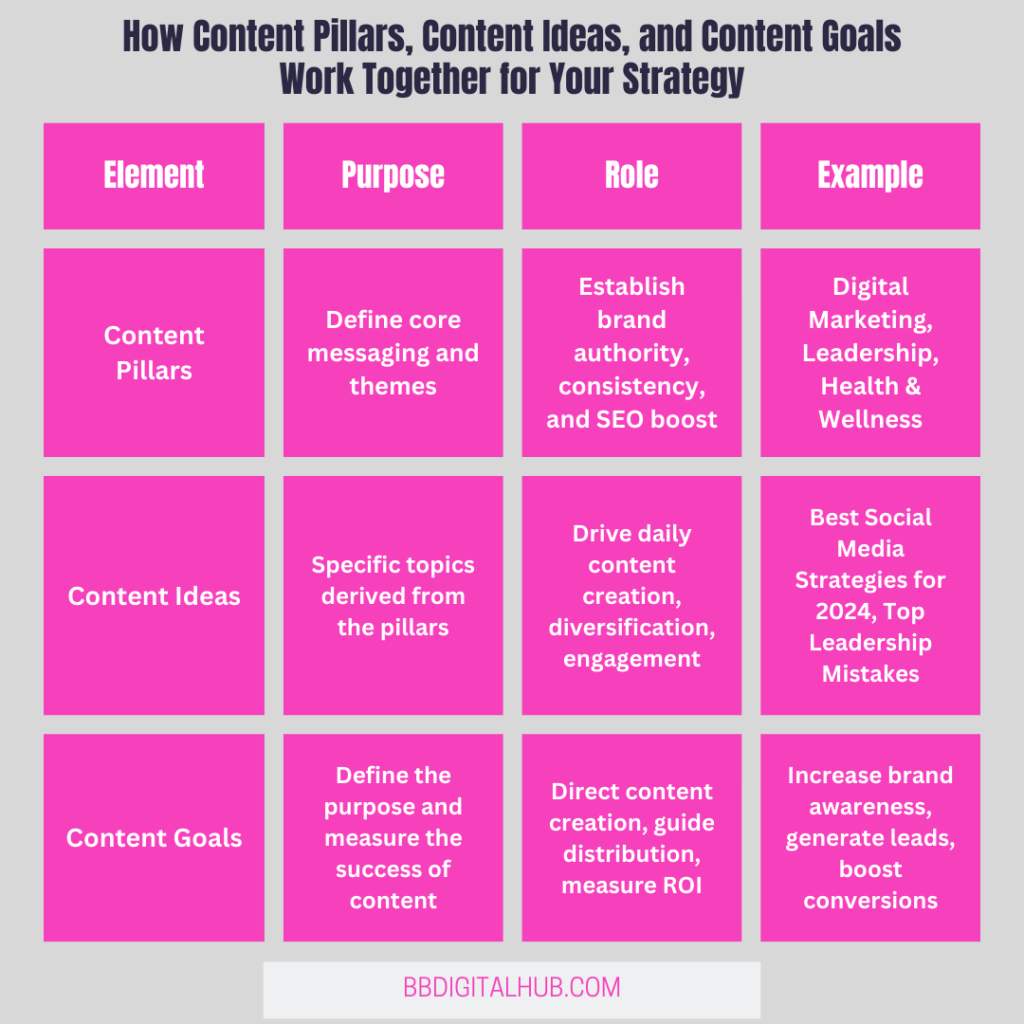
Step-by-Step Guide to Implementing a Content Strategy Using These Three Elements
Now that you know all three elements and their roles in your content strategy, you’re ready to put them all together.
Follow this step-by-step guide to help you.
Step 1: Define Your Business Goals
Start by clarifying your business goals. What are you aiming to achieve—brand awareness, lead generation, engagement, or sales? Having a clear picture of your goals will help guide your next steps.
Step 2: Establish Three to Five Core Content Pillars
Using the steps I mentioned earlier or the steps in this blog post. Identify the key themes that align with your business and address your audience’s needs. These pillars will serve as the foundation of your content plan.
Step 3: Brainstorm Content Ideas Under Each Pillar
Use SEO tools, competitor analysis, and customer feedback to create a diverse list of content ideas. Ensure these ideas are fresh, relevant, and can be adapted to various formats (blogs, videos, podcasts, etc.). You can also use AI tools to help with inspiration.
Step 4: Assign a Specific Content Goal to Each Idea
For every content idea, have a clear, measurable goal using the SMART framework. Ask yourself: What is the purpose of this content? How will I measure its success?
Step 5: Plan Content Distribution
Map out where and how you’ll share your content. What platform is your audience on? What platforms will your content perform best on? Will it be a blog post, a video, a social media snippet, or an email campaign?
Ensure each piece is tailored to its platform to maximize engagement.
Step 6: Track Performance and Optimize Strategy
Use analytics tools to monitor the performance of your content. Evaluate whether each piece meets its goal, and be ready to adjust your strategy based on the data you collect.
By following these steps and understanding the big three (content pillars, content ideas, content goals). It makes your content strategy not only easy to create but also effective.
And an effective content strategy is key to growing your business.
I hope this explanation was easy to understand. If you have any questions, let me know in the comments.
Also, if you struggle with any of the three elements, let me know, and we can work together.
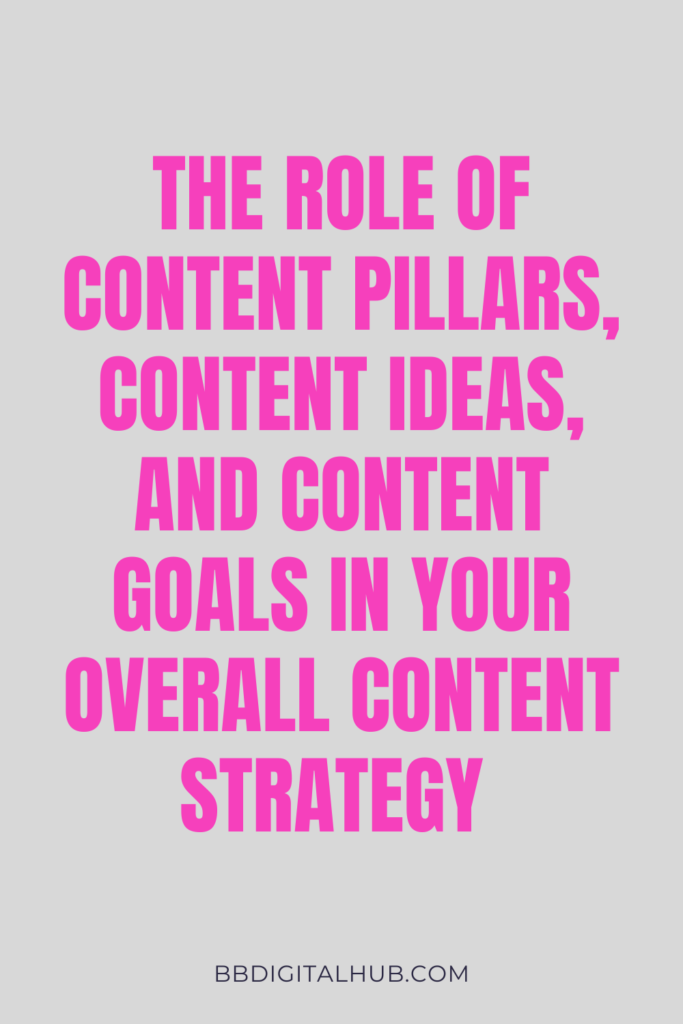
Join Our Community Today
Get exclusive access to straightforward marketing strategies tailored for beginners.

Leave a Reply